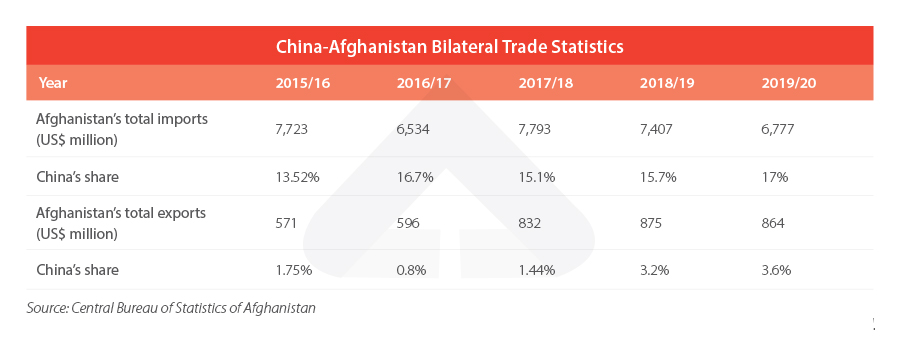China and Afghanistan: Bilateral Trade Relationship and Future Outlook (Updated)
As a country sharing borders with China, Afghanistan has been maintaining a close relationship with Beijing for security and regional development. Through Belt and Road Initiative (BRI) projects, the connectivity between the two countries is expected to get enhanced.
If concerns about regional security are adequately addressed, Afghanistan could attract foreign investment, export minerals, and develop transport services. China could benefit from the opened-up transport routes and mineral resources Afghanistan offers. Both sides are thus keen to reap opportunities from a secure trade environment.
China’s hopes for Afghanistan in the post-war era
Afghanistan shares a 90 km border with China at the end of the Wakhan Corridor in the northeast of the country and is an important participant in the BRI. Afghanistan is home to some of the largest untapped reserves of rare earth metals in the world, which China would like to gain access to.
Afghanistan’s peace and stability are thus of great interest to China. Following the US withdrawal of its troops from the region under NATO, China’s approach to the Afghan situation is unique among powers as Beijing has kept friendly relations with all major parties involved. A year after the Taliban’s takeover, China has emerged as a key player in negotiations with the new regime. During the 2022 Shanghai Cooperation Organization (SCO) and the Collective Security Treaty Organization (CSTO) joint summit, Xi Jinping stressed that all member states should join hands to safeguard peace and stability in Afghanistan. On that occasion, the Chinese president invited the SCO member states to make full use of platforms like the SCO-Afghanistan Contact Group and facilitate a smooth transition in Afghanistan.
In the past, China’s former Foreign Minister Wang Yi stressed that Beijing “would not interfere in the internal affairs of Afghanistan” while urging the country’s various factions to work to avoid expansion of the conflict and restart intra-Afghan negotiations.
He also called upon the Taliban to “recognize its responsibility toward the country and the nation, make a clean break with all terrorist forces and return to Afghanistan’s political mainstream with a sense of responsibility for the country and the people”.
China has taken a pragmatic approach to build relations with Afghanistan, willing to cooperate with the authority that is best situated to protect China’s domestic and regional interests.
China has previously engaged in dialogue with the Taliban, who have occupied territories across Afghanistan after the US withdrawal, including, crucially, the Badakhshan region on the border with China.
The Taliban appear eager to assure the Chinese government that their rule would not affect China’s stability and have said they welcome Chinese investments in Afghanistan. China also has close ties with Afghanistan’s neighbor, Pakistan, which could facilitate future regional trade and investment.
Although the course of Afghanistan’s near future remains to be seen, Beijing has been actively participating in the country’s reconstruction efforts.
China-Afghanistan relations
China established diplomatic relations with Afghanistan in 1955, and the two countries have generally maintained friendly relations throughout history. Both countries currently have embassies in their respective capitals.
Since 2001, China has kept a relative distance, refusing to put boots on the ground, but on occasion providing financial and military assistance to the Afghan central government.
In 2017, China began engaging in peacekeeping efforts between Pakistan and Afghanistan following deteriorating relations between the latter two countries. The three nations agreed to establish China-Afghanistan-Pakistan trilateral cooperation and held their first trilateral dialogue in late 2017.
In their fourth trilateral dialogue, held in June 2021, they reiterated their willingness to expand peace and stability in the region, and reaffirmed their commitment to deepening cooperation under the BRI. The three countries also confirmed their willingness to strengthen cooperation in tackling the COVID-19 pandemic and fighting terrorism.
It bears mentioning that the Afghan representative at these dialogues is the minister of foreign affairs of the Islamic Republic of Afghanistan, which is currently ruled by a coalition government. Although no country recognizes the Islamic Emirate of Afghanistan (the official name chosen by the Taliban coalition) as the rightful successor to the Islamic Republic of Afghanistan, since September 2021, there have been formal diplomatic discussions between the Taliban and other countries. China offers a valuable case to observe such mediation efforts.
Why Afghanistan holds importance to China’s strategic interests
From China’s vantage point, Afghanistan enjoys a strategic geographic position, offering a potential shortcut for imports of oil and gas from the Middle East, along with neighboring Pakistan.
China is therefore keen to expand cooperation under the BRI and build trade and transport routes involving Afghanistan. However, previous BRI projects in Afghanistan faced immense security risks, leading to some projects, such as a copper mining contract signed with the Chinese state-owned company MCC, failing to ever get off the ground.
Despite setbacks, some infrastructure projects have begun construction, including a US$5 million road that would connect Kabul with China through the Wakhan corridor.
It is clear that any expansion of BRI projects in Afghanistan, and by extension bilateral trade relations, are likely to face significant hurdles as long as the internal situation remains unstable. China is therefore likely to continue using its significant influence in the region to push for peace and stability.
Trade flow between China and Afghanistan
Afghanistan’s main trading partners are its neighbors, and China is one of its largest trading partners.
In 2020, China grew to become the second-largest export destination for Afghan goods after Pakistan. It was also the top source of imported goods for Afghan markets, following the United Arab Emirates (UAE), Pakistan, and India.
Over the last five years, China’s share in Afghanistan’s total imports and exports has been growing, as shown in the above table. Especially, the annual growth rate in the value of Afghanistan’s exports to China between 2016 to 2020 reached 105 percent, according to the International Trade Centre (ICT).
Afghanistan’s exports to China have grown over the last 25 years at a yearly rate of 4.84 percent, from US$16.6 million in 1995 to US$49.53 million in 2021. Edible fruits and nuts (US$44.8 million), wool and animal hair yarn (US$2.08 million), pearls, precious stones, metals, and coins (US$895,880) were the top exported products.
In 2021, China exported US$474.45 million worth of goods to Afghanistan, according to the United Nations COMTRADE database. The top exported products include electrical and electronic equipment (US$85.13 million), rubbers (US$81.94 million), machinery, nuclear reactors, and boilers (US$47.16 million), vehicles other than railway (US$39.71 million), and manmade staple fibers (US$28.04 million).
| Major Commodity Trade Between China and Afghanistan | |||
| Top five commodities Afghanistan exports to China |
Top five commodities China exports to Afghanistan |
||
| Commodity | Trade value (US$ million) | Commodity | Trade value (US$ million) |
| Edible fruits, nuts, peel of citrus fruit, melons | 44.8 | Electrical, electronic equipment | 85.13 |
| Wool, animal hair, horsehair yarn, and fabric | 2.08 | Rubbers | 81.94 |
| Pearls, precious stones, metals, and coins | 0.89 | Machinery, nuclear reactors, boilers | 81.94 |
| Cotton | 0.69 | Vehicles other than railway, tramway | 47.16 |
| Carpets and other textiles | 0.20 | Manmade staple fibers | 28.04 |
| Source: United Nations COMTRADE | |||
Multilateral engagement efforts
China and Afghanistan haven’t signed any free trade agreements (FTAs) or double taxation avoidance agreements (DTAs) yet.
However, the two sides have established the China-Afghanistan Joint Committee on Economics and Trade (JCET), which was held in 2010, 2015, and 2017.
In August 2014, China and Afghanistan signed the Exchange Notes Granting Zero-Tariff Treatment to the Exports of Some Afghan Goods to China. Since 2015, 97 percent of goods originating from Afghanistan can enjoy zero tariffs when exporting to China. China renewed this commitment on December 1, 2022, granting zero-tariff treatment to 98 percent of the tax items from Afghanistan. However, Afghanistan imposes relatively high tariff rates on raw material imports.
Belt and Road Initiative
As the US rolls back its strategic presence in Afghanistan, Chine senses both risks and opportunities.
Lying at the intersection of South Asia, Central Asia, and West Asia, Afghanistan is significant to China’s BRI projects. Once its political situation is stable and the necessary infrastructure is in place, the country has great potential to develop into a key regional trade hub.
The Silk Road trade routes
The new administration of Afghanistan has been in talks with China to reopen the historical Silk Road trade routes, particularly the Wakhan Corridor, an Afghan valley route that divides China and Tajikistan and connects China with Afghanistan via a 98 km-wide strip of land.
The IEA has announced its preparations for the opening of this corridor requesting the Chinese counterpart to cooperate on the project so as to increase the level of trade between the two countries and become a reliable route for the transit of goods.
The costly Wakhan Corridor project would aid in Afghanistan’s rebuilding and transition from a country mired in conflict to one that produces goods and enjoys peace. Although Chinese construction firms are capable, establishing a Wakhan Corridor route would cost tens of billions of dollars, with additional funds needed to provide security, vital transportation, and logistical services.
The Afghanistan-CPEC
China would be keen to extend the China-Pakistan Economic Corridor (CPEC), a flagship BRI project, to Afghanistan. Launched in 2013, the CPEC is focused on the construction of key infrastructure, including upgrades to the cross-border Karakoram Highway and the construction of the New Gwadar International Airport in the Balochistan province of Pakistan.
Chinese leaders have reportedly already been negotiating a deal with Kabul authorities to invest in Afghanistan’s infrastructure under the BRI.
Previously, Kabul was hesitant to approve deals with Beijing given how the US was heavily involved with the Afghan government. Now, authorities in Kabul are considering extending the US$62 billion CPEC.
China-Kyrgyzstan-Uzbekistan-Afghanistan corridor
In August 2022, Uzbekistan suggested the establishment of a new Central Asian “China-Kyrgyzstan-Uzbekistan-Afghanistan” transportation route.
The chiefs of the railways in Kyrgyzstan and Afghanistan met with the acting chairman of the board of Uzbekistan to discuss this idea. The Afghan Railways Director General, the Kyrgyz Railway Firm Director General, and officials of the Chinese Wakhan Corridor logistics company also attended the conference to discuss the project, with all parties involved.
According to the Uzbek side, establishing favorable circumstances for freight transportation is crucial when planning a new corridor, and introducing competitive rates is of utmost importance.
The development of such a corridor would help with the reconstruction of Afghanistan and assist with the transformation from a nation at perpetual war to production and peace.
North-south Trans-Afghan railway
In July 2022, China’s special envoy to Afghanistan, Yue Xiaogong, stated that Beijing is ready to support the implementation of Afghanistan transport projects, including a railway that would connect Uzbekistan’s Mazar-i-Sharif, Afghanistan’s capital city Kabul and Peshawar, in Pakistan,
Yue noted that “Beijing sees Afghanistan as a bridge between Central and South Asia” and added that “these megaprojects will help to a permanent peace on Afghan soil and deepen regional interconnection.”
It is expected that the north-south Trans-Afghan railway will at some point intersects a projected west-east route that would connect Iran to China via Afghanistan and Pakistan, as well as via Kabul and Peshawar. The Trans-Afghan lines will take precedence until a final link with China can be tried. Talks are currently ongoing on extending direct trains from Pakistan through to Kashgar in China’s Xinjiang Province.
Pine nuts air transport corridor
The trade of pine nuts between China and Afghanistan sheds insight into Beijing’s growing interest in the area along its western border. Opened in 2018, the so-called “pine nut air transport corridor” is an air freight route established between the two nations to help Afghanistan’s pine-nut business which brought a revenue of US$15 million for the locals within the first four months of its operation.
Under the corridor, between 3,000 and 5,000 tons of pine nuts are transported to China every year, which has brought tangible benefits to the people of both countries and transformed the air corridor into an important link for bilateral friendly cooperation. Afghanistan’s annual output of pine nuts is around 20,000 tons, reaching an export volume worth US$800 million. Against this background, the corridor will be able to create jobs for more than 100,000 locals.
Nevertheless, the afghan pine nuts market remains challenged by poor transportation infrastructure and years of war. As Afghanistan continues to lack the equipment and authorization required for processing pine nuts, China has essentially taken over Pakistan as the product refinery, receiving revenues from value-added processes.
Oil extraction deal
On January 5, 2022, the Afghanistan Taliban-led administration signed a deal with a Chinese company to extract oil from the Amu Darya basin and create an oil reserve in Sar-e Pul province in the northern part of the country. The acting minister of mines and petroleum, Sheikh Shahabuddin Delawar, and a representative of the Xinjiang Central Asia Petroleum and Gas Co (CAPEIC) signed the agreement during a ceremony in the Afghan capital.
The deal represents the first significant energy extraction arrangement with a foreign company since the Taliban takeover in 2021. The Chinese side will invest up to US$150 million annually, which will grow to US$540 million in three years.
Afghanistan is believed to hold natural resources worth more than U$1 trillion, including copper, rare earths, and natural gas. However, due to the country’s protracted instability, a large portion of such deposits remain untapped.
Meanwhile, a second Chinese state-owned enterprise is in discussions with the Taliban-led government about mining activities at the Mes Aynak copper mine close to Kabul, which would be following up on a U$3 billion, 30-year contract signed in 2008 under the previous administration.
Shanghai Cooperation Organization
Afghanistan started to engage with the Shanghai Cooperation Organization (SCO) in 2005 by signing a protocol establishing the SCO-Afghanistan contact group. In 2012, Afghanistan became an observer in the SCO and has been striving to get full membership since 2015. By far, this application hasn’t been approved yet and Afghanistan is still an observer in the SCO, though Pakistan and India gained full membership in July 2017.
Afghanistan is geographically part of the SCO region and has close historical and economic relations with most SCO states. Practically speaking, the Afghan Civil War was a major reason for the formation of the SCO in the first place. Afghanistan and the SCO have common interests in the restoration and maintenance of regional security by combating terrorism, extremism, and opium cultivation.
During the 2022 SCO foreign ministers’ meeting in Uzbekistan, former Chinese Foreign Minister Wang Yi met with his Taliban counterpart, Amir Khan Muttaqi. On that occasion, Wang announced that China would not charge tariffs on 98 percent of goods imported from Afghanistan to boost bilateral trade ties.
As mentioned earlier, any future opportunity transpiring between China and Afghanistan will rely heavily on the security situation of the region. In this regard, the SCO could play an important role for cooperation and joint development.
Through the SCO, China aims to give Afghanistan new opportunities. At the same time, Beijing also urges Afghanistan, especially the interim Taliban regime, to honor its security commitments and ensure the safety of the Afghan people, diplomats in Afghanistan, and Chinese citizens. Only in this way can they gain strong support from China and other countries.
Within the framework of the SCO, China proposed to carry out practical cooperation in various fields with member states and observer states. If Afghanistan can introduce cooperation projects in such areas, the country will be able to get financial, technical, and personnel support from the other member states, including China. This is a brand new and valuable opportunity for Afghanistan, which is in dire need of reconstruction and urgently needs post-war reconstruction yet remains isolated by Western countries.
Summary
With diminishing US presence and the evolving security paradigm in Afghanistan, the importance of the country in Beijing’s foreign policy thinking has increased. A stable Afghanistan would aid China in its long-term economic plans in the Central Asian region. Therefore, China has the political will to push for peace and stability in Afghanistan. Despite facing upheavals and the halting of projects, Afghanistan’s vast amount of minerals and hydrocarbons remain attractive to Chinese investors and companies. In turn, as Kabul actively seeks foreign assistance to help its weak economy, Beijing’s economic clout makes it a preferred partner to work with.
China and Afghanistan are important trading partners for each other, although this relationship has the potential to grow and diversify. China’s continuous market opening also serves up opportunities for Afghani exporters and businesses.
Businesses should keep an eye on developments in the region to mitigate the risks caused by geopolitical complexities. If the security situation in the region becomes clearer and more certain, there would be substantial scope for growth in bilateral investment and regional trade momentum.
This article was first published on August 4, 2022, and last updated on January 10, 2023.
About Us
China Briefing is written and produced by Dezan Shira & Associates. The practice assists foreign investors into China and has done so since 1992 through offices in Beijing, Tianjin, Dalian, Qingdao, Shanghai, Hangzhou, Ningbo, Suzhou, Guangzhou, Dongguan, Zhongshan, Shenzhen, and Hong Kong. Please contact the firm for assistance in China at china@dezshira.com.
Dezan Shira & Associates has offices in Vietnam, Indonesia, Singapore, United States, Germany, Italy, India, and Russia, in addition to our trade research facilities along the Belt & Road Initiative. We also have partner firms assisting foreign investors in The Philippines, Malaysia, Thailand, Bangladesh.
- Previous Article China–Turkmenistan: Bilateral trade, Investment, and Future Prospects
- Next Article Belt And Road Weekly Investor Intelligence #115

























